
Holy Week: A biblical chronology and liturgical guide
“St. Athanasius calls Easter ‘the Great Sunday’ and the Eastern Churches call Holy Week ‘the Great Week.’ The mystery of the Resurrection, in which Christ […]

“St. Athanasius calls Easter ‘the Great Sunday’ and the Eastern Churches call Holy Week ‘the Great Week.’ The mystery of the Resurrection, in which Christ […]

The Church calls this day by two names: Palm Sunday and Passion Sunday. The first, for victory—the name most people recognize, not surprisingly; the second, for suffering—the one most folks would sooner forget. But in […]

The Annunciation by Fra Angelico. / Credit: Public domain via Wikimedia Commons
National Catholic Register, Apr 8, 2024 / 04:00 am (CNA).
Today we celebrate the solemnity of the Annunciation. Usually it’s celebrated on March 25, but this year M… […]

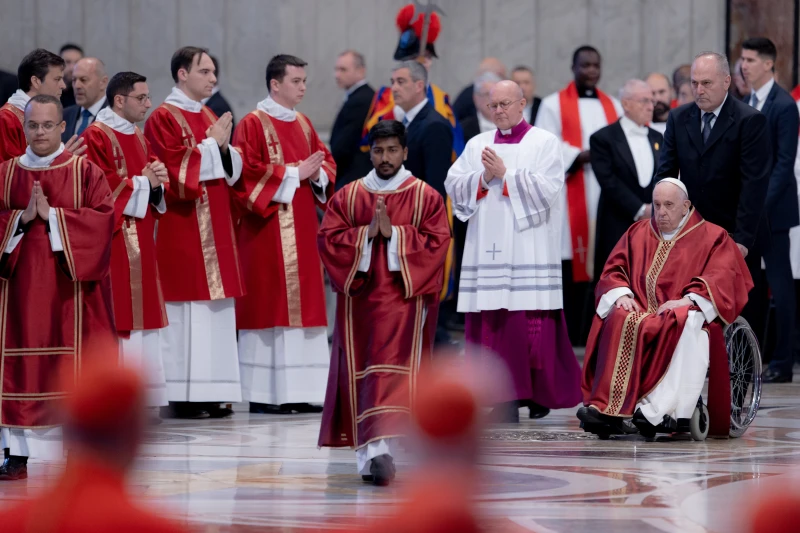 Pope Francis arrives at the Liturgy of the Lord’s Passion in St. Peter’s Basilica on Good Friday on April 7, 2023. / Credit: Daniel Ibanez/CNA
Pope Francis arrives at the Liturgy of the Lord’s Passion in St. Peter’s Basilica on Good Friday on April 7, 2023. / Credit: Daniel Ibanez/CNA
Rome Newsroom, Mar 29, 2024 / 08:00 am (CNA).
The Good Friday liturgy commemorates the apex of Christ’s passion with a remembrance of his crucifixion and death at Calvary.
The Good Friday Reproaches are a series of antiphons, known also as the “Improperia” or “Popule Meus” (“My people”), coming from the opening lines of the Latin text of the recitation.
Dating back to the ninth century, though not gaining a permanent place in the Roman Orders until the 14th century, the Good Friday Reproaches have long been an essential part of the Roman liturgy. But they largely disappeared from many parishes following the liturgical reforms of the Second Vatican Council.
The antiphons have, however, retained their prominence at the Vatican — and they will be chanted by the Sistine Chapel Choir during the Good Friday service presided over by Pope Francis on Friday in St. Peter’s Basilica.
In the moment leading up to the dramatic recitation, the priest chants three times, in an increasing pitch, “Ecce Lignum Crucis,” or “Behold the wood of the cross,” each time gradually unveiling the cross that hitherto has been covered in a purple veil.
Once the crucifix is placed in a central location at the edge of the sanctuary, cast against a bare altar, the faithful are invited to kneel before — and kiss — it, a powerful remembrance of Christ’s passion but also a recognition of the cross as an instrument of salvation.
During the adoration of the cross, the Good Friday Reproaches are chanted in an alternating manner between a cantor and choir. It opens: “Popule meus, quid feci tibi? Aut in quo contristavi te? Responde mihi” (“My people, what have I done to you? How have I offended you? Answer me”).
This hauntingly sorrowful and beautiful text is followed by the first reproach: “Quia eduxi te de terra Aegypti: parasti Crucem Salvatori tuo” (“Because I led thee out of the land of Egypt: thou hast prepared a cross for thy Savior”), showcasing the world’s fatal rejection of Christ despite his love and saving acts.
The following is the full text of the reproaches:
Popule meus, quid feci tibi?
Aut in quo contristavi te?
Responde mihi.
(O my people, what have I done to thee?
Or how have I offended you?
Answer me.)
Quia eduxi te de terra Aegypti:
parasti Crucem Salvatori tuo.
(Because I led thee out of the land of Egypt:
thou hast prepared a cross for thy Savior.)
Hagios o Theos.
Sanctus Deus.
Hagios Ischyros.
Sanctus fortis.
Hagios Athanatos, eleison himas.
Sanctus immortalis, miserere nobis.
(O holy God!
O holy God!
O holy strong One!
O holy strong One!
O holy and immortal, have mercy upon us.
O holy and immortal, have mercy upon us.)
Quia eduxi te per desertum quadraginta annis:
et manna cibavi te, et introduxi te in terram satis bonam:
parasti Crucem Salvatori tuo.
Hagios . . .
(Because I led thee through the desert for forty years:
and fed thee with manna, and brought thee into a land exceeding good:
thou hast prepared a cross for thy Savior.
O holy God! . . .)
Quid ultra debui facere tibi, et non feci?
Ego quidem plantavi te vineam meam speciosissimam:
et tu facta es mihi nimis amara:
aceto namque sitim meam potasti:
et lancea perforasti latus Salvatori tuo.
Hagios . . .
(What more ought I to have done for thee, that I have not done?
I planted thee, indeed, my most beautiful vineyard:
and thou hast become exceeding bitter to me:
for in my thirst thou gavest me vinegar to drink:
and with a spear thou hast pierced the side of thy Savior.
O holy God! . . .)
Ego propter te flagellavi Aegyptum cum primogenitis suis:
et tu me flagellatum tradidisti.
Popule meus . . .
(For thy sake I scourged the firstborn of Egypt:
Thou hast given me up to be scourged.
O my people . . .)
Ego te eduxi de Aegypto, demerso Pharone in mare Rubrum:
et tu me tradidisti principibus sacerdotum.
Popule meus . . .
(I led thee out of Egypt, having drowned Pharaoh in the Red Sea:
and thou hast delivered me to the chief priests.
O my people . . .)
Ego ante te aperui mare:
et tu aperuisti lancea latus meum.
Popule meus . . .
(I opened the sea before thee:
and thou hast opened my side with a spear.
O my people . . .)
Ego ante te praeivi in columna nubis:
et tu me duxisti ad praetorium Pilati.
Popule meus . . .
(I went before thee in a pillar of cloud:
and thou hast led me to the judgment hall of Pilate.
O my people . . .)
Ego te pavi manna in desertum:
et tu me cedisti alapis et flagellis.
Popule meus . . .
(I fed thee with manna in the desert:
and thou hast assaulted me with blows and scourges.
O my people . . .)
Ego te potavi aqua salutis de petra:
et tu me potasti felle et aceto.
Popule meus . . .
(I gave thee the water of salvation from the rock:
and thou hast given me gall and vinegar to drink.
O my people . . .)
Ego propter te Chananeorum reges percussi:
et tu percussisti arundine caput meum.
Popule meus . . .
(For thy sake I struck the kings of the Canaanites:
and thou hast struck my head with a reed.
O my people . . .)
Ego dedi tibi sceptrum regale:
et tu dedisti capiti meo spineam coronam.
Popule meus . . .
(I gave thee a royal scepter:
and thou hast given a crown of thorns for my head.
O my people . . .)
Ego te exaltavi magna virtute:
et tu me suspendisti in patibulo crucis.
Popule meus . . .
(I exalted thee with great strength:
and thou hast hanged me on the gibbet of the cross.
O my people . . .)

Mother Angelica. / Credit: Eternal Word Television Network
ACI Prensa Staff, Mar 24, 2024 / 14:00 pm (CNA).
Mother Angelica, foundress of the Eternal Word Television Network (EWTN), CNA’s parent company, once offered helpful advice for Holy Wee… […]

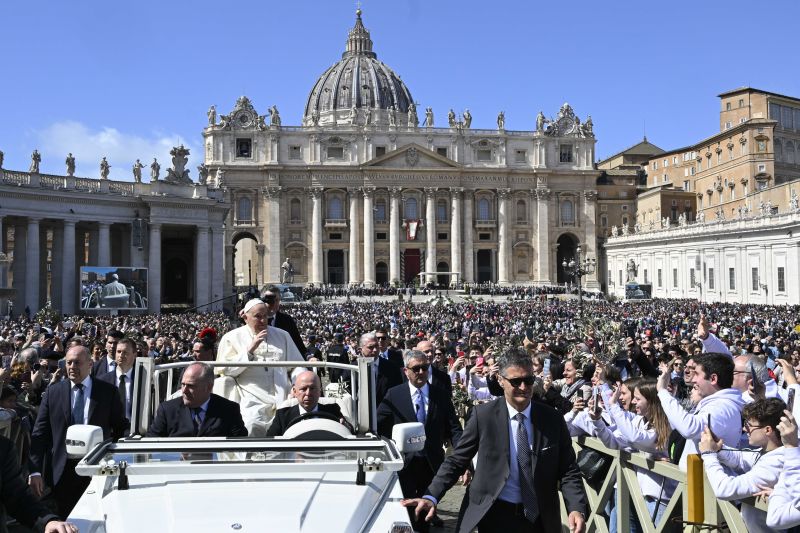 Pope Francis at Palm Sunday Mass in St. Peter’s Square on March 24, 2024. / Vatican Media
Pope Francis at Palm Sunday Mass in St. Peter’s Square on March 24, 2024. / Vatican Media
Vatican City, Mar 24, 2024 / 11:52 am (CNA).
Pope Francis offered prayers for the victims of the “vile terrorist attack” in Moscow at the end of his Palm Sunday Mass at the Vatican.
At least 130 people died after gunmen opened fire at a musical performance in a Moscow concert hall on Friday night, according to the Associated Press.
The Islamic State group’s Afghanistan affiliate claimed responsibility for the attack in Russia — a claim that U.S. intelligence officials have confirmed.
Speaking in St. Peter’s Square on March 24, Pope Francis prayed for the families of the victims as well as for the conversion of the perpetrators of the attack.
“May the Lord receive them in his peace and comfort their families. May he convert the hearts of those who plan, organize, and carry out these inhuman actions, which offend God, who commanded, ‘You shall not kill,’” the pope said.
After offering prayers for the victims in Moscow, Pope Francis made a long appeal for peace in Ukraine, asking people to pray in particular for those in Ukraine who do not have electricity.
“Let us pray for all our brothers and sisters who are suffering because of war,” the pope said.
“In a special way, I am thinking of martyred Ukraine, where so many people find themselves without electricity because of the intense attacks against infrastructure that, in addition to causing death and suffering, carry the risk of an even larger humanitarian catastrophe.”
Pope Francis added: “Please, do not forget the tormented Ukraine. And let us think about Gaza, which suffers so much, and so many other places of war.”
The pope gave his peace appeal at the end of Palm Sunday Mass, where he opted not to give a homily at the last minute without explanation.
Before praying the Angelus with the crowd at the end of Mass, Francis gave a brief reflection on the Gospel account of Jesus’ entry into Jerusalem on a donkey.
“Dear brothers and sisters, Jesus entered Jerusalem as a humble and peaceful King. Let us open our hearts to Him. Only He can deliver us from enmity, hatred, violence, for He is the mercy and forgiveness of sins,” Pope Francis said.
The 87-year-old pope, who arrived at the Mass in a wheelchair, has a busy week ahead as he is scheduled to preside over liturgies each day of the Easter Triduum.
“And now we turn in prayer to the Virgin Mary. Let us learn from her to stay close to Jesus during the days of Holy Week, in order to arrive at the joy of the Resurrection,” Pope Francis said.

 Pope Francis at the Easter Vigil Mass in St. Peter’s Basilica on April 8, 2023. / Credit: Vatican Media
Pope Francis at the Easter Vigil Mass in St. Peter’s Basilica on April 8, 2023. / Credit: Vatican Media
Rome Newsroom, Feb 29, 2024 / 12:10 pm (CNA).
The Vatican has released Pope Francis’ schedule for Holy Week 2024, which will include five papal liturgies, Stations of the Cross at the Colosseum, and other traditions to mark the most sacred week of the year.
Easter is the highest feast in the Catholic Church, known as the “solemnity of solemnities,” celebrating Jesus’ resurrection and defeat of sin and death, and the Vatican celebrates Holy Week with pomp, reverence, tradition, and a busy schedule.
The 87-year-old pope is scheduled to preside over liturgies on each day of the Easter Triduum as well as Palm Sunday.
The Holy See Press Office published the pope’s Holy Week schedule one day after Pope Francis visited the hospital for diagnostic tests. Reuters reported that the pope had a CT scan during the hospital checkup. Last year, Pope Francis was discharged from the hospital one day before presiding over Palm Sunday Mass.
Holy Week 2024 begins on March 24 with Palm Sunday and culminates with Easter on March 31. Here is the Vatican’s full schedule:

On Sunday morning, March 24, Pope Francis is scheduled to preside over Mass for Palm Sunday, also known as Passion Sunday or the Commemoration of the Lord’s Entrance into Jerusalem.
The Mass, which will be in St. Peter’s Square at 10 a.m. local time, will kick off with a grand procession of deacons, priests, bishops, cardinals, and laypeople carrying palms.
The procession includes olive tree branches, palm fronds, and the large, weaved palms called “parmureli,” all blessed by Pope Francis.
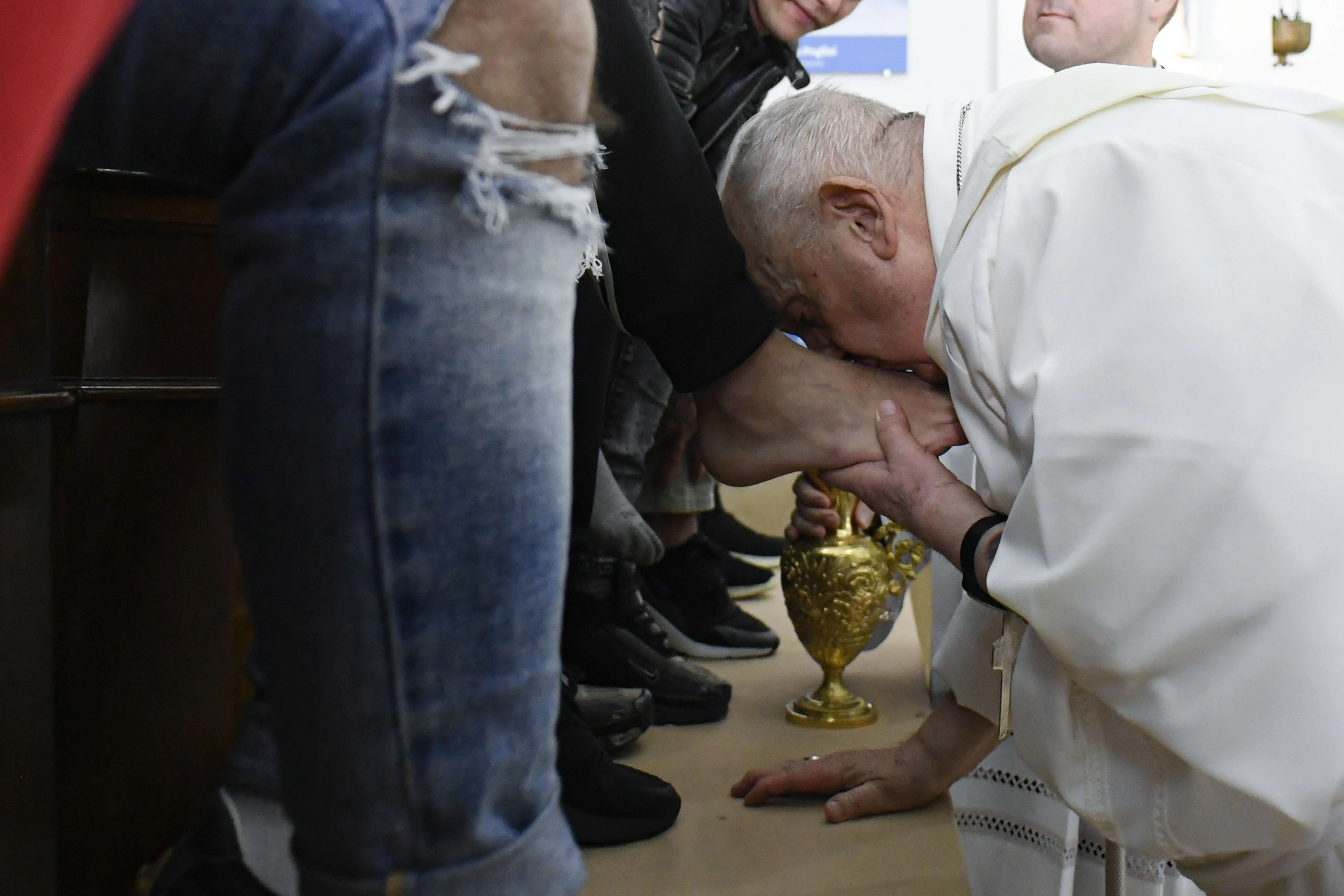
Pope Francis is set to start Holy Thursday with a chrism Mass in St. Peter’s Basilica at 9:30 a.m. in the presence of cardinals, bishops, and priests living in Rome.
During the Mass, Pope Francis, as the bishop of Rome, will bless the oil of the sick, the oil of catechumens, and the chrism oil to be used in the diocese during the coming year.
The Vatican has yet to release the details for where Pope Francis will celebrate Holy Thursday Mass 2024. Last year, the pope offered Mass at the juvenile detention center Casal del Marmo, the same detention center where he offered Holy Thursday Mass in 2013 shortly after his election.

Continuing the liturgies of the Triduum, Pope Francis is also scheduled to preside over a celebration for the Passion of the Lord on Good Friday at 5 p.m. in St. Peter’s Basilica.
During this liturgy, which is not a Mass, Cardinal Raniero Cantalamessa, the papal preacher, typically preaches instead of the pope.
In the evening, Pope Francis will lead the Stations of the Cross devotion at 9:15 p.m. in Rome’s Colosseum illuminated by candlelight.
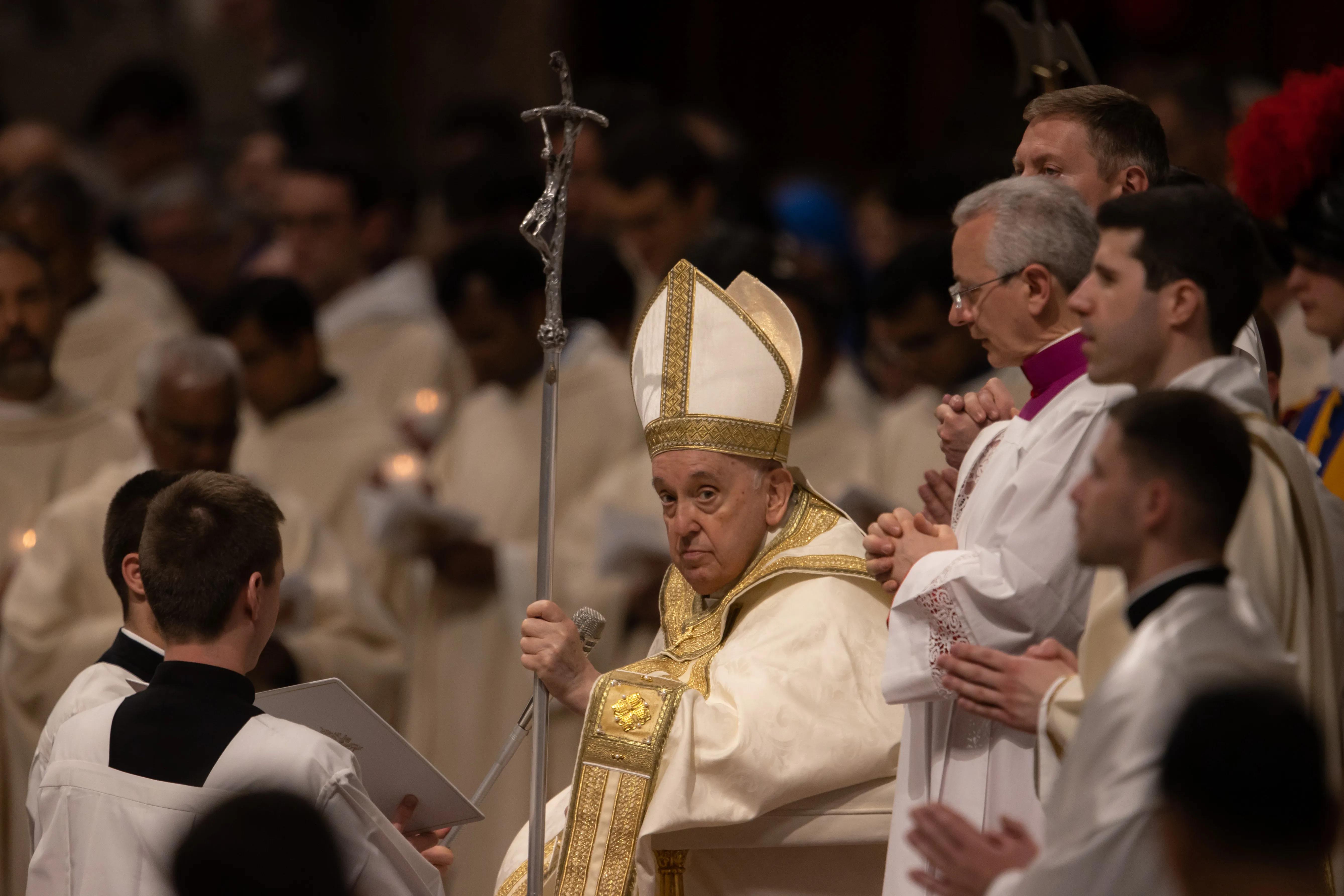
On Holy Saturday, Pope Francis is set to preside over the Easter Vigil at 7:30 p.m. in St. Peter’s Basilica.
The Easter Vigil, which takes place on Holy Saturday night, “is the greatest and most noble of all solemnities,” according to the Roman Missal.
The liturgy begins in darkness with the blessing of the new fire and the preparation of the paschal candle. At the Vatican, cardinals, bishops, and priests process through the dark basilica carrying lit candles to signify the light of Christ coming to dispel the darkness.
Pope Francis also typically baptizes new Catholics at this Mass.
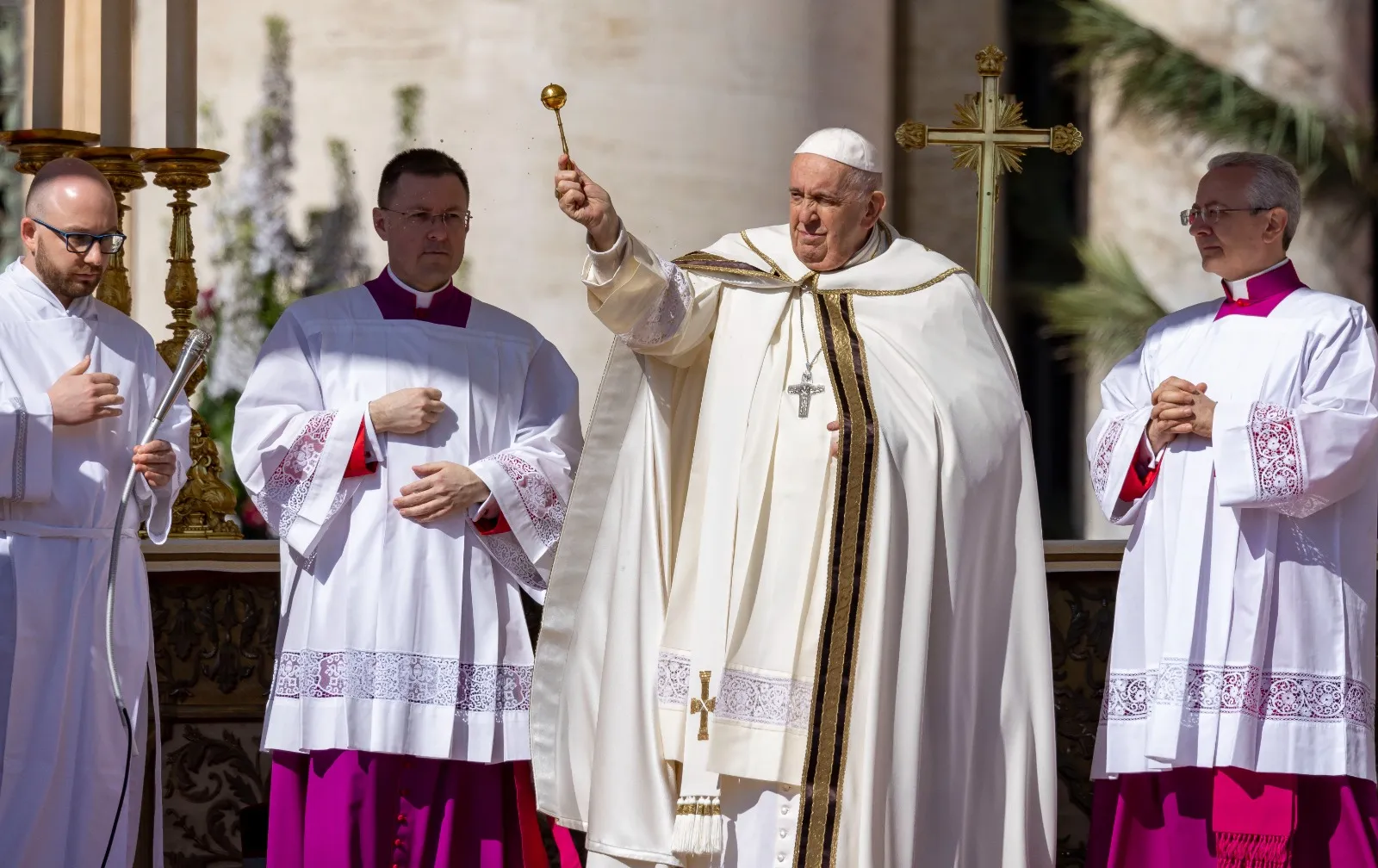
The morning of Easter Sunday, Pope Francis will preside over Mass in St. Peter’s Square at 10 a.m. on a flower-decked parvise.
After Mass, he will give the annual Easter “urbi et orbi” blessing at noon from the central balcony of St. Peter’s Basilica.
“Urbi et orbi” means “to the city [of Rome] and to the world” and is a special apostolic blessing given by the pope every year on Easter Sunday, Christmas, and other special occasions.
In 2023, local authorities estimated that there were close to 100,000 people present in St. Peter’s Square for the blessing.

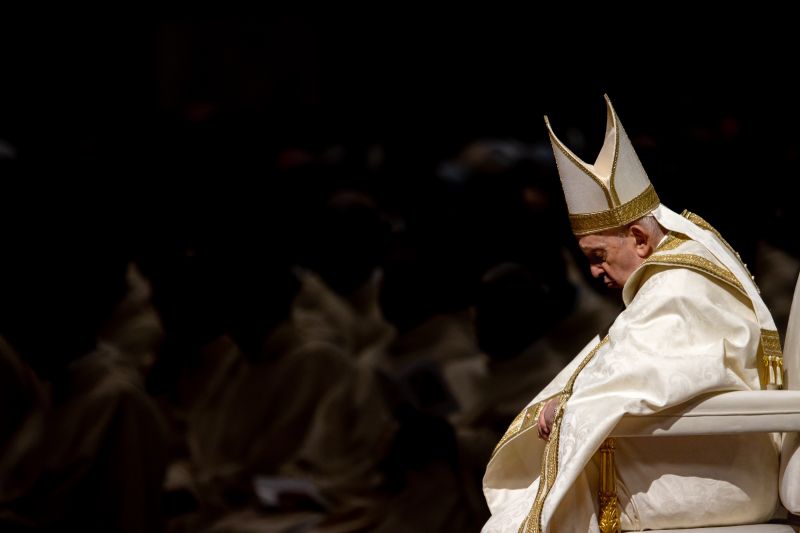 Pope Francis prays during the Easter Vigil Mass in St. Peter’s Basilica on April 8, 2023. / Daniel Ibanez/CNA
Pope Francis prays during the Easter Vigil Mass in St. Peter’s Basilica on April 8, 2023. / Daniel Ibanez/CNA
Vatican City, Apr 8, 2023 / 15:00 pm (CNA).
Here is the full text of Pope Francis’ Easter Vigil homily, delivered on April 8 in St. Peter’s Basilica.
The night is drawing to a close and the first light of dawn is appearing upon the horizon as the women set out toward Jesus’ tomb. They make their way forward, bewildered and dismayed, their hearts overwhelmed with grief at the death that took away their Beloved. Yet upon arriving and seeing the empty tomb, they turn around and retrace their steps. They leave the tomb behind and run to the disciples to proclaim a change of course: Jesus is risen and awaits them in Galilee. In their lives, those women experienced Easter as a Pasch, a passage. They pass from walking sorrowfully towards the tomb to running back with joy to the disciples to tell them not only that the Lord is risen, but also that they are to set out immediately to reach a destination, Galilee. There they will meet the Risen Lord; that is where the resurrection leads them. The rebirth of the disciples, the resurrection of their hearts, passes through Galilee. Let us enter into this journey of the disciples from the tomb to Galilee.
The Gospel tells us that the women went “to see the tomb” (Mt 28:1). They think that they will find Jesus in the place of death and that everything is over, forever. Sometimes we too may think that the joy of our encounter with Jesus is something belonging to the past, whereas the present consists mostly of sealed tombs: tombs of disappointment, bitterness, and distrust, of the dismay of thinking that “nothing more can be done”, “things will never change”, “better to live for today”, since “there is no certainty about tomorrow”. If we are prey to sorrow, burdened by sadness, laid low by sin, embittered by failure, or troubled by some problem, we also know the bitter taste of weariness and the absence of joy.
At times, we may simply feel weary about our daily routine, tired of taking risks in a cold, hard world where only the clever and the strong seem to get ahead. At other times, we may feel helpless and discouraged before the power of evil, the conflicts that tear relationships apart, the attitudes of calculation and indifference that seem to prevail in society, the cancer of corruption … the spread of injustice, the icy winds of war. Then too, we may have come face to face with death, because it robbed us of the presence of our loved ones or because we brushed up against it in illness or a serious setback. Then it is easy to yield to disillusionment, once the wellspring of hope has dried up. In these or similar situations … our paths come to a halt before a row of tombs, and we stand there, filled with sorrow and regret, alone and powerless, repeating the question, “Why?” … The women at Easter, however, do not stand frozen before the tomb; rather, the Gospel tells us, “They went away quickly from the tomb, fearful yet overjoyed … and ran to announce this to his disciples” (v. 8). They bring the news that will change life and history forever: Christ is risen! (v. 6). At the same time, they remember to convey the Lord’s summons to the disciples to go to Galilee, for there they will see him (cf. v. 7). Brothers and sisters, what does it mean to go to Galilee? Two things: on the one hand, to leave the enclosure of the Upper Room and go to the land of the Gentiles (cf. Mt 4:15), to come forth from hiding and to open themselves up to mission, to leave fear behind and to set out for the future. On the other hand–-and this is very good—to return to the origins, for it was precisely in Galilee that everything began. There the Lord had met and first called the disciples. So, to go to Galilee means to return to the grace of the beginnings, to regain the memory that regenerates hope, the “memory of the future” bestowed on us by the Risen One.
This, then, is what the Pasch of the Lord accomplishes: it motivates us to move forward, to leave behind our sense of defeat, to roll away the stone of the tombs in which we often imprison our hope, and to look with confidence to the future, for Christ is risen and has changed the direction of history. Yet, to do this, the Pasch of the Lord takes us back to the grace of our own past; it brings us back to Galilee, where our love story with Jesus began. Where was that first call? In other words, it asks us to relive that moment, that situation, that experience in which we met the Lord, experienced his love, and received a radiantly new way of seeing ourselves … the world around us, and the mystery of life itself. To rise again, to start anew, to take up the journey, we always need to return to Galilee, that is, to go back, not to an abstract or ideal Jesus, but to the living, concrete, and palpable memory of our first encounter with him. Yes, brothers and sisters, to go forward we need to go back, to remember; to have hope, we need to revive our memory. This is what we are asked to do: to remember and go forward! If you recover that first love, the wonder and joy of your encounter with God, you will keep advancing. So remember, and keep moving forward. Remember, and keep moving forward.
Remember your own Galilee and walk towards it, for it is the “place” where you came to know Jesus personally, where he stopped being just another personage from a distant past, but a living person: not some distant God but the God who is at your side, who more than anyone else knows you and loves you. Brother, sister, remember Galilee, your Galilee, and your call. Remember the Word of God who at a precise moment spoke directly to you. Remember that powerful experience of the Spirit; that great joy of forgiveness experienced after that one confession; that intense and unforgettable moment of prayer; that light that was kindled within you and changed your life; that encounter, that pilgrimage. … Each of us knows the place of his or her interior resurrection, that beginning and foundation, the place where things changed. We cannot leave this in the past; the Risen Lord invites us to return there to celebrate Easter. … Remember your Galilee. Remind yourself.
Today, relive that memory. Return to that first encounter. Think back on what it was like, and reconstruct the context, time, and place. Remember the emotions and sensations; see the colors and savor the taste of it. For, you know, it is when you forgot that first love when you failed to remember that first encounter, that the dust began to settle on your heart. That is when you experienced sorrow and, like the disciples, you saw the future as empty, like a tomb with a stone sealing off all hope. Yet today, brothers and sisters, the power of Easter summons you to roll away every stone of disappointment and mistrust. The Lord is an expert in rolling back the stones of sin and fear. He wants to illuminate your sacred memory, your most beautiful memory, and to make you relive your first encounter with him. Remember and keep moving forward. Return to him and rediscover the grace of God’s resurrection within you …
Dear brothers and sisters, let us follow Jesus to Galilee, encounter him, and worship him there, where he is waiting for each of us. Let us revive the beauty of that moment when we realized that he is alive and we made him the Lord of our lives. Let us return to Galilee. … Let each of us return to his or her own Galilee, to the place where we first encountered him. Let us rise to new life!

The Liturgy of the Passion of the Lord in St. Peter’s Basilica on April 7, 2023. / Daniel Ibanez/CNA
Vatican City, Apr 7, 2023 / 12:30 pm (CNA).
On Good Friday, Pope Francis presided over the Liturgy of the Passion of the Lord in St. Peter’s Ba… […]

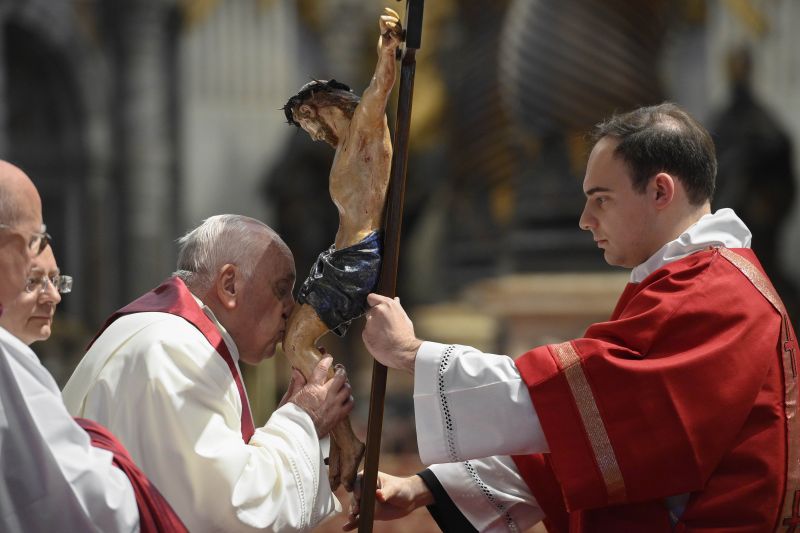 Pope Francis kisses the crucifix at the Liturgy of the Lord’s Passion in St. Peter’s Basilica on April 7, 2023. / Vatican Media
Pope Francis kisses the crucifix at the Liturgy of the Lord’s Passion in St. Peter’s Basilica on April 7, 2023. / Vatican Media
Vatican City, Apr 7, 2023 / 12:00 pm (CNA).
At the Vatican’s Good Friday liturgy, the papal preacher warned against the danger of believers being drawn into the “vortex of nihilism” by the post-modern world’s “total relativism.”
Cardinal Raniero Cantalamessa, O.F.M. Cap., compared Friedrich Nietzsche’s words “God is dead” with the Catholic Church’s proclamation of the death of Christ as he preached at the Liturgy of the Lord’s Passion on April 7 in St. Peter’s Basilica in the presence of Pope Francis.
At the beginning of the liturgy, Pope Francis arrived at the basilica dressed in red vestments in a wheelchair. Unlike in previous years, he was unable to lay prostrate but spent a moment in silent prayer before the main altar at the beginning of the liturgy.

The Vatican announced earlier in the day that the 86-year-old pope, who was hospitalized with bronchitis last week, will not be attending the Stations of the Cross at the Colosseum on Friday night due to cold weather.
In his homily, Cantalamessa noted that the Catholic Church has proclaimed the death of Christ for 2,000 years. He said: “At every Mass, after the consecration, we say or sing: ‘We proclaim your death, O Lord, and profess your Resurrection until you come again.’”
“Yet another ‘death of God’ has been proclaimed for a century and a half in our de-Christianized Western world. When, among cultivated people, one speaks of the ‘death of God,’ it is this other death of God – ideological and rather than historical – that is meant. To keep up with the times, some theologians hastened to build a theology around it: ‘The theology of the death of God.’”
“We cannot pretend to ignore the existence of this different narrative, without leaving prey to suspicion many believers,” he added.
Cantalamessa, who was made a cardinal in 2020 in recognition of his more than 40 years as Preacher of the Papal Household, said that he chose to speak about this topic “to keep believers – who knows, perhaps even just one or two university students – from being drawn into this vortex of nihilism which is the true ‘black hole’ of the spiritual universe.”

With relativism in the fields of ethics, philosophy, art, and religion, “nothing more is solid; everything is liquid, or even vaporous,” the cardinal said.
“As believers, it is our duty to show what there is behind, or underneath, that proclamation, namely the flicker of an ancient flame, the sudden eruption of a volcano that has never been extinguished since the beginning of the world,” he said.
After the homily, a deacon and Pope Francis read the 11 Good Friday Solemn Intercessions, which included prayers for the Jewish people, those who do not believe in God, and those suffering from war.
The Adoration of the Cross then took place, followed by the recitation of the Our Father and Holy Communion. Pope Francis kissed the crucifix after spending a moment in silent adoration standing at the foot of the cross.
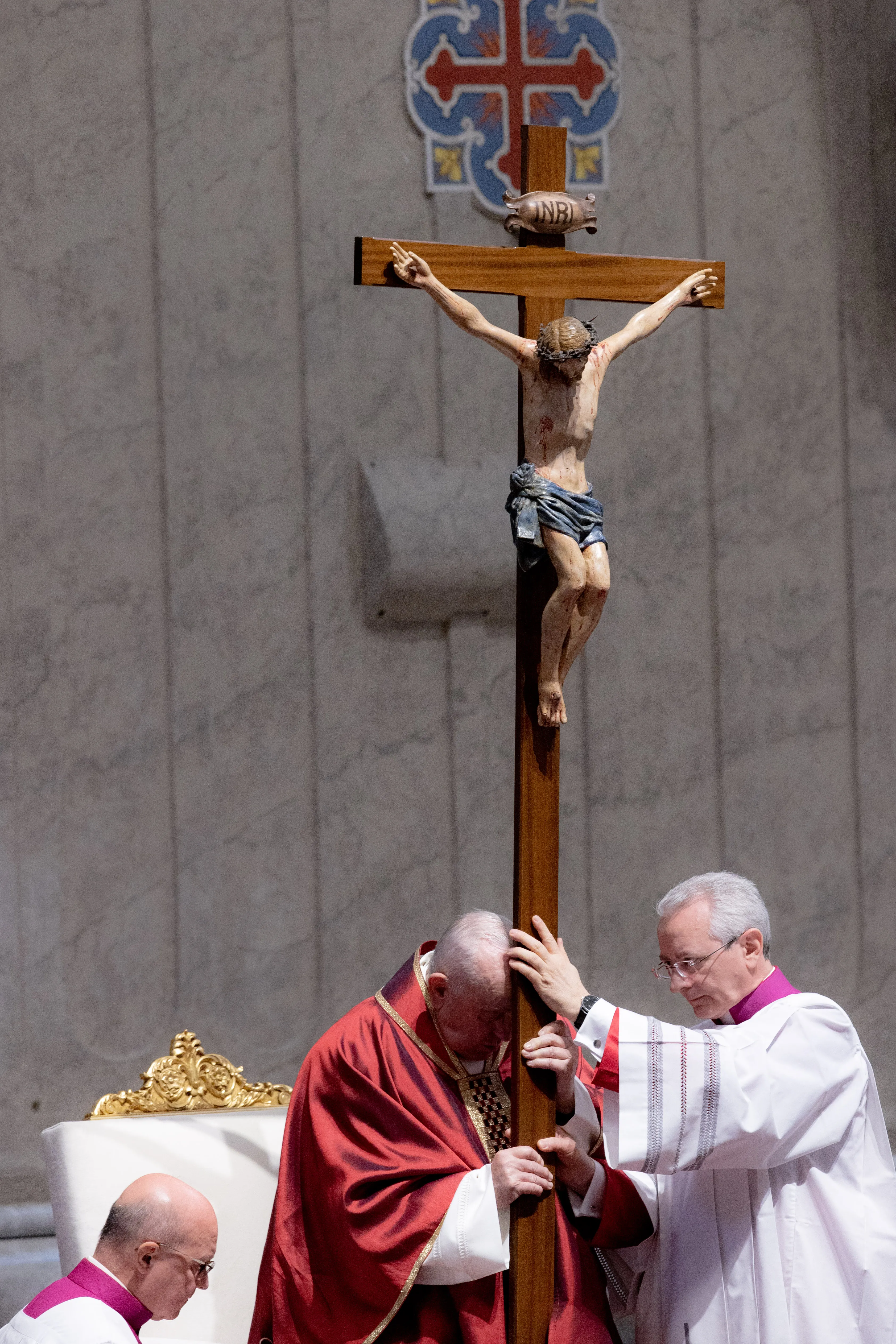
During his homily, Cantalamessa urged Christians to heed a warning from Dante Alighieri, who wrote in the Divine Comedy: “‘Christians, be ye more serious in your movements; Be ye not like a feather at each wind, And think not every water washes you.’”
The cardinal said: “Let us, therefore, continue to repeat, with heartfelt gratitude and more convinced than ever, the words we proclaim at every Mass: ‘We proclaim your death, O Lord, and profess your Resurrection until you come again.’”
© Catholic World Report